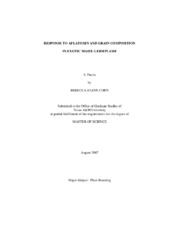| dc.description.abstract | Exotic germplasm has potential to provide new alleles for disease and insect resistance. US maize (Zea mays L.) currently lacks genetic resistance to Aspergillus flavus, a fungal pathogen that produces aflatoxin in maize kernels. Aflatoxin is one of the main limitations to maize production in hot, dry regions like the Southern US because of the harmful effects on humans and animals and subsequent marketing regulations. Two experiments were conducted to evaluate different exotic maize collections for response to aflatoxin. Exotic adapted maize lines, known as LAMA lines, were found to accumulate less aflatoxin than US hybrids in tests across Southern Texas. Exotic introgression lines developed by The International Center for Maize and Wheat Improvement (CIMMYT) including inbred lines, yellow hybrids, and white hybrids, were more resistant to aflatoxin than US inbred lines and hybrids in field trials in Texas, Georgia, and Mississippi. Another experiment evaluated the grain composition of hybrids with exotic adapted LAMA maize lines and a collection of US hybrids, quality protein maize (QPM) hybrids, and advanced breeding lines using near-infrared spectroscopy. Individual LAMA lines and advanced breeding lines have higher starch content than US hybrid checks. Starch content was the primary grain composition trait of interest as an enhanced-value market has emerged for high starch maize hybrids. Limited germplasm has been analyzed for grain composition because wet chemistry analysis methods required large sample sizes and were time and labor intensive. The near infrared spectroscopy (NIR) method requires a relatively small sample and is a non-destructive analysis method. In this study, NIR was effective at ranking genotypes based on starch, oil, and protein content of the grain. | en |


